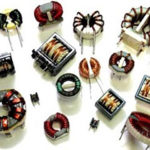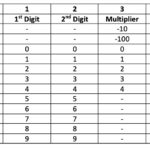In the previous tutorials, we discussed two passive properties of electronic components, resistance and capacitance, and their electronic components, resistors and capacitors. Passive components are unable to generate energy, but can store or dissipate it.
We’ve already learned about the electrical properties of resistors and capacitors, including how they affect the current and voltage in a circuit and they types that are commercially available. However, there’s another passive electronic component that’s also important to discuss: inductors.
Inductors are electronic devices that offer inductance in a circuit. Inductance is the ability of an inductor to store energy in the form of a magnetic field and to oppose changes in current.
To properly understand inductance, it’s important to first comprehend magnetism and electromagnetism.
Magnetism
Magnets have two poles. The north-seeking pole of a magnet is its north pole and the south-seeking one is the south pole. The unlike poles of different magnets attract and the similar or like poles repel one another. Magnets also attract certain metals, such as iron.
The area around a magnet that has an influence on moving electric charges (where it attracts or repels other magnets or metals) is the magnetic field. The magnetic field is described mathematically as a vector field.
A magnetic field is invisible but often depicted as lines of magnetic flux. Flux lines provide an illustration of the magnetic lines around a magnet. So, the magnetic force is applied along these flux lines and the strength of this field is determined by the concentration of the flux lines.
A magnetic force is also strongest near each of the magnet’s poles, where the flux lines converge (or come closer together).
Electromagnetism
Electricity and magnetism are connected. The interaction of electric currents and magnetic fields is electromagnetism.
For example, let’s imagine current flowing through a straight wire that passes through a perpendicular plane. If metals such as iron fillings are placed on the plane, they’ll form a concentric circle around the wire — which indicates that the current flowing through the straight wire has circular flux lines around it.
If, instead, the wire is shaped like a loop, the magnetic flux lines of a current would be more similar to that of a bar magnet. A bar magnet typically has a rectangular shape with magnetic poles at each end.
The greater number of loops that a wire has, the greater the number of flux lines and the stronger the magnetic field. The field around a current-carrying wire is also strongest near the wire.
When electric charges are stationary, they exert an attractive electrostatic force on opposing charges and a repulsive electrostatic force on the same charges. However, when electric charges are in motion, they exert a magnetic force on other charges.
In other words, when charges are in motion, their electrostatic force is converted into a magnetic force. Magnetism is caused by the motion of electric charges and is considered a feature of electricity.
Since charges exert an electrostatic or magnetic force on each other all the time, it can be said that electrical energy, magnetism, and mechanical energy are naturally interconvertible.
Dipoles and monopoles
As discussed, magnets have two opposite poles. A dipole refers to the pair of opposing magnetic poles, where as a monopole is one lone pole. Technically, monopoles do not exist as magnetic flux lines always connect two opposing poles in a closed loop (like in a bar magnet).
However, moving electric charges that exert a magnetic force can be considered monopoles when the flux lines around the charge are in concentric circles (such as a single rod or a radio antenna).
When a charge is stationary, it exerts an electrostatic force that’s radially and equally distributed in every directions. Such equally distributed radial electric field lines point inward as a negative charge or outward, indicating a positive charge. The stationary charges have no magnetic field or flux lines around them.
When a charge moves with a constant velocity, the electric flux lines are radial and point either inward or outward. But, they’re not uniformly distributed.
Due to the motion of charge, some of the electrostatic energy will convert to magnetic energy and concentric circular magnetic flux lines will appear along a plane perpendicular to the direction of the motion of charge.
When a charge accelerates, the electric flux lines are radial but will converge and concentrate near the charge. Due to acceleration of the charge, the magnetic field around the charge will become distorted and emit electromagnetic energy in the form of electromagnetic radiations.
Therefore, whenever there’s an accelerated charge, some of the energy will be lost in the form of electromagnetic waves.
The strength of a magnetic field
The magnitude of a magnetic field as a unit is a Weber (Wb). The magnitude of weak magnetic fields is a Maxwell. One Weber is equivalent to 108 Maxwell.
The intensity of the magnetic force in a magnetic field is determined by the flux density or intensity of the field at a certain point in time. The flux density at a point is the number of magnetic lines per square meter or per square centimeter at a set point in the magnetic field. The flux density is measured in units, as Tesla and Gauss.
One Tesla of magnetic field intensity is defined as one Weber of magnetic field per square meter. One Gauss of magnetic field intensity is defined as one Maxwell of magnetic field per square centimeter. One Tesla is equivalent to 104 Gauss.
Permeability, paramagnetism, ferromagnetism, and diamagnetism
Magnetic flux lines can pass through all materials. In fact, earth itself is a giant magnet. The bar magnets aligning along the north and south poles of the earth are similar to the iron fillings aligning along the north and south poles of a bar magnet.
However, different materials respond differently to a magnetic field.
- Paramagnetic materials are magnetized in a magnetic field and demagnetized if this field is removed.
- Ferromagnetic materials are magnetized such that they remain so even if the magnetic field is removed.
- Diamagnetic materials do not get magnetized by a magnetic field at all.
When paramagnetic or ferromagnetic materials are held freely in a magnetic field, they’ll align along the magnetic flux lines, much like the iron fillings of a bar magnet. When diamagnetic materials are held freely in a magnetic field, they’ll align perpendicular to the magnetic flux lines, opposing any magnetization.
When magnetic flux lines pass through paramagnetic and ferromagnetic materials, the intensity of the magnetism increases as they come closer to the material. While when magnetic flux lines pass through diamagnetic materials, the magnetism decreases as they come closer to the material.
Most metals are paramagnetic and most non-metals are diamagnetic. Iron, nickel, cobalt, and other rare earth metals are ferromagnetic. This includes several alloys of iron, nickel, and rare earth metals with additional elements (such as a permalloy, which is a nickel–iron magnetic alloy) and ferrites (compounds made of iron, oxygen, and other elements). Lodestone, which is a naturally occurring magnet, is a ferrite compound of iron and oxygen.
Permeability is the ability of a material to support a magnetic flux and is an indication of the degree of magnetization that a material can obtain in response to a magnetic field. For example, the permeability of a vacuum and air is 1. The permeability of an iron core can range from 60 to 8000, depending upon its purity. Permalloys can have permeability up to 1,000,000.
The cause of magnetism
So, why is it that certain materials are subject to a magnetic field while others are not?
Materials are made up of atoms. An atom consists of a positively charged nucleus, surrounded by one or more negatively charged particles, known as electrons. Electrons rotate on their own axis.
Most of the electrons in atoms exist in pairs that spin in opposite directions, canceling their magnetic effect.
When electrons that have opposite spins are put together, there is no net magnetic field because the positive and
If unpaired, an electron in an atom or molecule has a net magnetic field, making it a microscopic magnet. Paramagnetic and ferromagnetic materials are made up of atoms or molecules with unpaired electrons.
If unpaired electrons are exposed to a magnetic force that’s perpendicular to the direction of their velocity and the direction of the magnetic field, it causes the unpaired electrons to move as such that they produce a magnetic field along the applied magnetic flux lines. Essentially, the unpaired electrons of paramagnetic atoms realign in response to external magnetic fields and are attracted.
Therefore, paramagnetic and ferromagnetic materials can get magnetized in a magnetic field when the unpaired electrons creating a net magnetic field inside the material.
In diamagnetic materials, there are no unpaired electrons. The electrons revolving in their atoms will experience a force from an applied magnetic field, which produces a weak magnetic field that opposes the applied magnetic field. This is why, diamagnetic materials when held freely in a magnetic field, align themselves perpendicular to the direction of applied magnetic flux lines.
It should be noted that magnetism in permanent magnets also happens only due to the motion of unpaired electrons.
Retentivity
Retentivity or remanence is the measured ability of a material to remain magnetized even after removing an external magnetic field.
Paramagnetic materials immediately get demagnetized when an applied magnetic field is removed but ferromagnetic materials retain magnetism, even after the removal of the magnetic field.
Retentivity is expressed as percentage of flux density retained by the material after removing the external magnetic field. So, if on applying an external magnetic field, a material has a flux density of “y” Tesla and on removing the external magnetic field, it retains a flux density of “x” Tesla, then the Retentivity will be 100 * x/y.
Inductance
We’ve learned that when a current flows through a looped wire, a magnetic field is induced. Whenever the current varies or changes direction, this magnetic field opposes the flow of current by inducing a voltage in reverse polarity.
In other words, the energy that was stored by the coil in the form of a magnetic field is converted back to an electrical field opposing the change in magnitude or direction of the current. The property of a material, by which it opposes any change in magnitude or direction of current through it, is inductance.
The unit of inductance is Henry. Inductance is one Henry when the current through a coil is changing at a rate of one ampere per second, inducing a voltage of one volt across it. Henry is a large unit. More typically, inductance is expressed in Milli-Henry or Micro-Henry.
Inductance can be a useful phenomenon in electronic circuits. The electronic devices designed to offer inductance in a circuit are inductors.
We’ll discuss more about inductors and their signal behavior in the next article.
You may also like:
Filed Under: Tutorials












Questions related to this article?
👉Ask and discuss on EDAboard.com and Electro-Tech-Online.com forums.
Tell Us What You Think!!
You must be logged in to post a comment.